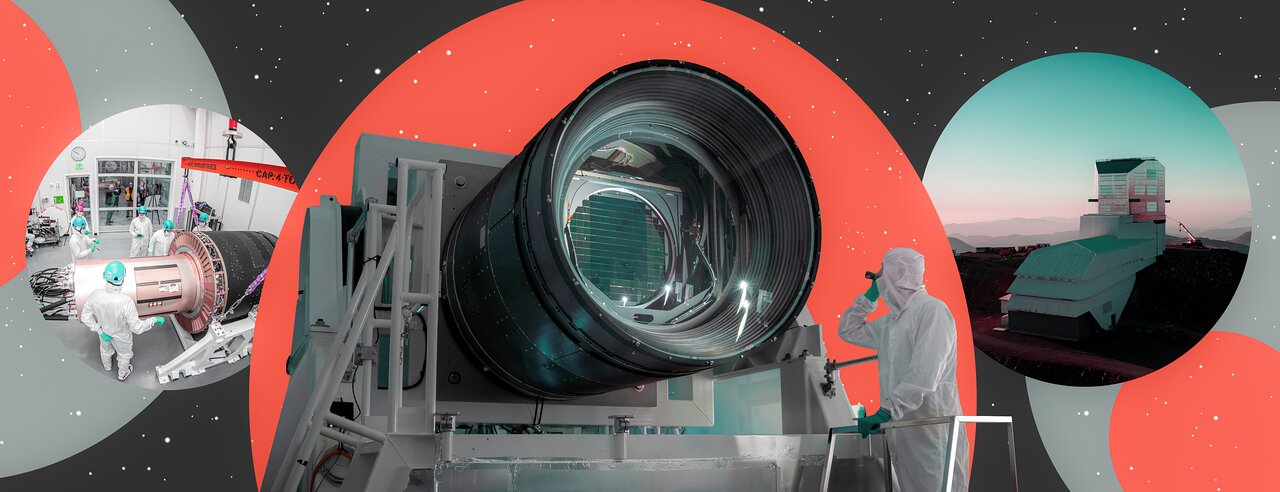The Vera C. Rubin Observatory, formerly the Large Synoptic Survey Telescope (LSST), was formally proposed in 2001 to create an astronomical facility that could conduct deep-sky surveys using the latest technology. This includes a wide-field reflecting telescope with an 8.4-meter (~27.5-foot) primary mirror that relies on a novel three-mirror design (the Simonyi Survey Telescope) and a 3.2-megapixel Charge-Coupled Device (CCD) imaging camera (the LSST Camera). Once complete, Rubin will perform a 10-year survey of the southern sky known as the Legacy Survey of Space and Time (LSST).
While construction on the observatory itself did not begin until 2015, work began on the telescope’s digital cameras and primary mirror much sooner (in 2004 and 2007, respectively). After two decades of work, scientists and engineers at the Department of Energy’s (DOE) SLAC National Accelerator Laboratory and their collaborators announced the completion of the LSST Camera – the largest digital camera ever constructed. Once mounted on the Simonyi Survey Telescope, this camera will help researchers observe our Universe in unprecedented detail.
The Vera C. Rubin Observatory is jointly funded by the U.S. National Science Foundation (NSF) and the U.S. Department of Energy (DOE) and is cooperatively operated by NSF NOIRLab and SLAC. When Rubin begins its ten-year survey (scheduled for August 2025), it will help address some of the most pressing and enduring questions in astronomy and cosmology. These include understanding the nature of Dark Matter and Dark Energy, creating an inventory of the Solar System, mapping the Milky Way, and exploring the transient optical sky (i.e., objects that vary in location and brightness).

The LSST Camera will assist these efforts by gathering an estimated 5,000 terabytes of new raw images and data annually. “With the completion of the unique LSST Camera at SLAC and its imminent integration with the rest of Rubin Observatory systems in Chile, we will soon start producing the greatest movie of all time and the most informative map of the night sky ever assembled,” said Željko Ivezic, an astronomy professor at the University of Washington and the Director of Rubin Observatory Construction in a NoirLab press release.
Measuring 1.65 x 3 meters (5.5 x 9.8 ft), with a front lens over 1.5 m (5 ft) across, the camera is about the size of a small SUV and weighs almost 2800 kg (6200 lbs). Its large-aperture, wide-field optical imaging capabilities can capture light from the near-ultraviolet (near-UV) to the near-infrared (NIR), or 0.3 – 1 micrometers (?m). But the camera’s greatest attribute is its ability to capture unprecedented detail over an unprecedented field of view. This will allow the Rubin Observatory to map the positions and measure the brightness of billions of stars, galaxies, and transient objects, creating a robust catalog that will fuel research for years.
Said Kathy Turner, the program manager for the DOE’s Cosmic Frontier Program, these images will help astronomers unlock the secrets of the Universe:
“And those secrets are increasingly important to reveal. More than ever before, expanding our understanding of fundamental physics requires looking farther out into the Universe. With the LSST Camera at its core, Rubin Observatory will delve deeper than ever before into the cosmos and help answer some of the hardest, most important questions in physics today.”
In particular, astronomers are looking forward to using the LSST Camera to search for signs of weak gravitational lensing. This phenomenon occurs when massive galaxies alter the curvature of spacetime around them, causing light from more distant background galaxies to become redirected and amplified. This technique allows astronomers to study the distribution of mass in the Universe and how this has changed over time. This is vital to determining the presence and influence of Dark Matter, the mysterious and invisible matter that makes up 85% of the total mass in the Universe.
Similarly, scientists also want to study the distribution of galaxies and how those have changed over time, enabling them to identify Dark Matter clusters and supernovae, which may help improve our understanding of Dark Matter and Dark Energy alike. Within our Solar System, astronomers will use the LSST Camera to create a more thorough consensus of small objects, including asteroids, planetoids, and Near-Earth Objects (NEO) that could pose a collision risk someday. It will also catalog the dozen or so interstellar objects (ISOs) that enter our Solar System every year.
This is an especially exciting prospect for scientists who hope to conduct rendezvous missions in the near future that will allow us to study them up close. Now that the LSST Camera is complete and has finished being tested at SLAC, it will be shipped to Cerro Pachón in Chile (where the Vera C. Rubin Observatory is being constructed) and integrated with the Simonyi Survey Telescope later this year. Said Bob Blum, Director for Operations for Vera C. Rubin Observatory:
“Rubin Observatory Operations is very excited to see this major milestone about to be completed by the construction team. Combined with the progress of coating the primary mirror, this brings us confidently and much closer to starting the Legacy Survey of Space and Time. It is happening.”
The LSST Camera was made possible thanks to the expertise and technology contributed by international partners. These include the Brookhaven National Laboratory, which built the camera’s digital sensor array; the Lawrence Livermore National Laboratory and its industrial partners, who designed and built the lenses; the National Institute of Nuclear and Particle Physics in France, which built the camera’s filter exchange system and contributed to the sensor and electronics design.
Further Reading: NoirLab

